Where next? It’s the question I hear most often from people I meet on the road. I usually get oohs and aahs and nods of excitement when I reply, but when I began telling people I was headed to Vilnius, their response was almost always, “Where?” My explanation that Vilnius is the capital of Lithuania generally resulted in blank stares, or an occasional “What?”
I’d long wanted to visit the Baltic States of Lithuania, Latvia, and Estonia. I’d heard tales of a youthful, creative, hi-tech culture and rocket fast wifi. So when I decided to stay in Europe this summer, I did so with the Baltics in mind. Lithuania, the largest of the three, was my first goal, but getting there proved problematic.
I’d read on The Man in Seat 61 (the world’s best train information website) that it was possible to take a train from Krakow, Poland, to Lithuania. But at the train station, I was told over and over, “It’s not possible. There are no rails to Lithuania.” Buses were little better. I could get there, but every line would have required changing buses in mid-journey and would have dumped me off at midnight in Vilnius.

Getting to Vilnius from Warsaw seemed much easier, so I hopped on a train to the Polish capital and spent a few days in that surprisingly lovable city. From there I could take an Ecolines bus that would depart Warsaw at 9:30 p.m. and get me to Vilnius at 7:15 a.m. Perfect! Or so I thought, until the first text message arrived. “Estimate bus delayed two hours.” I drew my hoodie tighter around me and settled onto a low wall to wait. Around midnight, the bus from the competing line, Lux Express, arrived. Half of the waiting passengers bundled aboard, happy to be out of the cold and finally on their way. I texted Ecolines for an update and was told there had been an accident on the highway between Berlin and Warsaw. My bus was caught behind a huge traffic backup. The new estimate was that it would arrive in Warsaw before 2 a.m.
Thinking it might be better to wait a day, I trooped back to my hotel with my luggage. Unfortunately, they were sold out, so I returned to the cold, windy street corner. By the time my bus finally pulled up to the curb at 2:30 a.m. I was exhausted and chilled to the bone, but grateful to finally be underway. That gratitude was hard to hold onto. The man in the seat next to me had shoulders the width of two men and insisted on hogging the armrest between us. My seat was so thinly upholstered that within minutes it felt like my hips were seated directly on the sharp metal undercarriage. The bathroom was filthy and reeked but I had no choice but to use it.

I finally arrived in Vilnius around 2:30 p.m. and made a beeline for my Air B&B apartment. The owners were out of town but they had arranged for a wonderful young man named Valentyn to meet me upon arrival. He carried my suitcase up the stairs, handed me the keys and left me to recover, promising to return the following day to tell me what to do in Vilnius. I didn’t know it at the time, but Valentyn is an accomplished photographer, and he was excited to meet me. Over vegetarian platters the next evening, we flipped through the pages of his portfolio. Each photo was more evocative that the last. I particularly liked his black and white landscapes, all of which had been shot around Vilnius. I’d spent the day wandering and had already fallen in love with the Lithuanian capital, but his photos really got my creative juices flowing. I wanted to see every site that was featured in his portfolio.
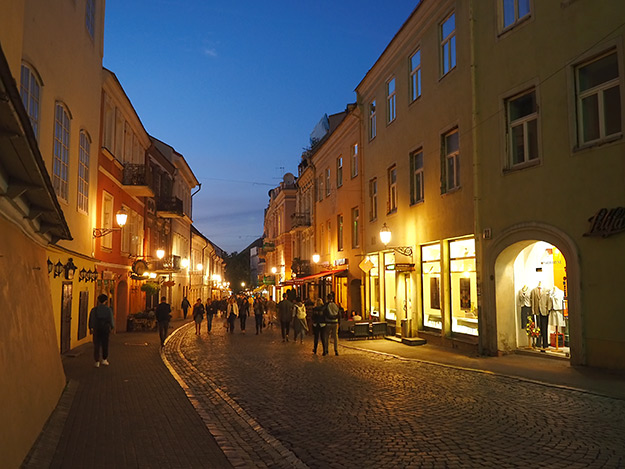
I started with Vilnius’ historic Old Town. Many of the old buildings are in obvious need of repair, but Lithuania is a poor country with no money to restore buildings. For me, this was a plus. I later visited the Old Towns in both Riga, Latvia, and Tallinn, Estonia, the other two Baltic States. There is no denying that they are both beautiful; Riga especially has one of the largest collections of Art Nouveau architecture in Europe. But both Riga and Tallinn seemed sterile, as if they had been wiped clean of the influence of local life and existed only for the benefit of tourists. Not so in Vilnius.

Sidewalk cafes lined the brick-paved streets of Old Town and the occasional souvenir shop had found residence along the main streets, however Vilnius felt different to me. Lithuanian was the prevalent language being spoken in every coffee shop, every restaurant, every church, and at every tourist site I visited. Because restoration efforts are the exception rather than the norm, locals can still afford to live in the historic district. While a bit raw and ragged around the edges, real life goes on in the heart of Vilnius.
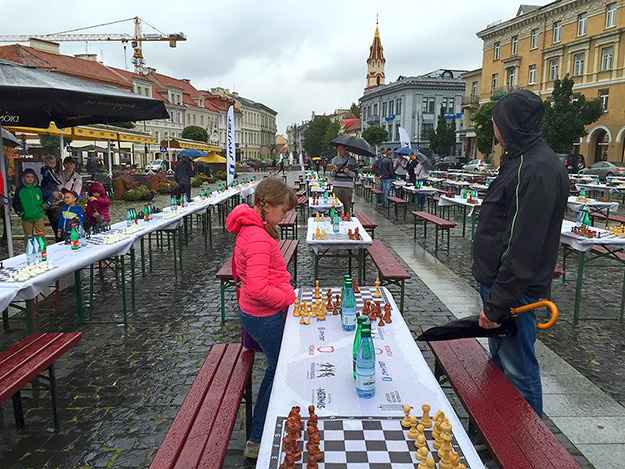
On the day I arrived, Town Hall Square was set up with long rows of tables, upon which sat chessboards. The weather was grey and drizzly, but that didn’t seem to deter participants. As the day wore on, more and more locals clustered beneath umbrellas to challenge competitors. I mentioned my surprise that the tournament would go on despite the rain to Valentyn and he just laughed. “If rain kept us from doing things here, nothing would ever happen.”

Despite Valentyn’s insistence that it rains a lot in Vilnius, the remainder of my days were filled with clear cerulean skies and the early autumn temperatures were perfect for walking. One day I crossed the Vilnia River into Uzupis. Once a derelict, rundown neighborhood where prostitutes and homeless squatted in abandoned buildings, Uzupis has been transformed into a Bohemian district filled with artists. I meandered along the riverbank, popping into one gallery after another, chatting with artists about their works. Today the district is known as “The Republic of Uzupis.” Residents declared themselves independent on April Fool’s Day in 1997 and wrote their own tongue-in-cheek constitution, which has been translated into 23 languages and mounted on a prominent wall. Just steps away, The Angel of Uzupis blows her trumpet from atop a tall column. Some say she is a symbol of the resurgence of Uzipis, while others insist she trumpets the eternal right to artistic freedom.
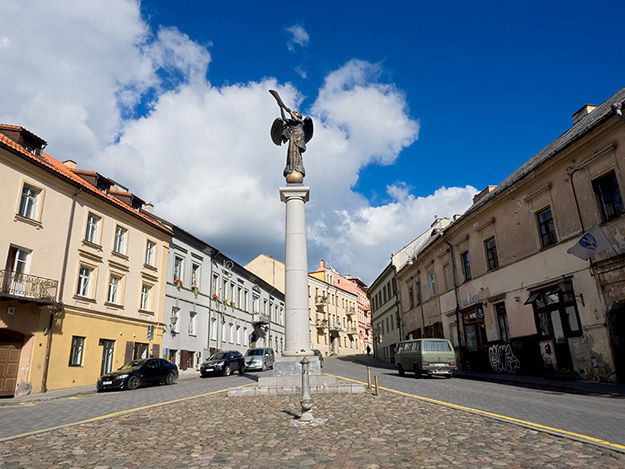
Another day, I worked my way north along the Vilnia River. I stopped at St. Anne’s Church, with its exquisite Gothic facade, and its Baroque companion, the Church of St. Francis and St. Bernard. Behind the churches, I strolled through peaceful Bernardinai Garden to Gediminas Hill. Rather than climb the steep path to the top, I opted to take the Funicular. Less than ten minutes later I was standing next to Gediminas Tower, the best preserved building within the ruins of Vilnius Castle. Vilnius spread far below me in all its glory, from glittering skyscrapers in the business district to the immense green spaces that surround the city.

Back at the bottom, I continued around the base of the hill to Cathedral Square, which stands at the crossing of the city’s two main streets. The reconstructed Royal Palace stands at the rear of the square, but it is Vilnius Cathedral that most come to see. The Church of Saints Stanislaus and Ladislaus (its official name) is the heart of Catholic spiritual life in Lithuania. It has seen the crowning of Kings and numerous famous people from Lithuanian and Polish history are buried in its crypts. The interior of the church is a veritable treasure house of art, featuring pieces from the 16th to the 19th centuries, and at least one fresco that dates back to the end of 14th century.
Perhaps most fascinating is the church’s free-standing bell tower, something of an anomaly outside Italy. Most historians now believe the belfry was originally a tower in the defensive wall of the city, however a persistent rumor is that the base of the bell tower was once a small pagan temple. Whatever the truth, the lower portion of the tower is medieval in origin.
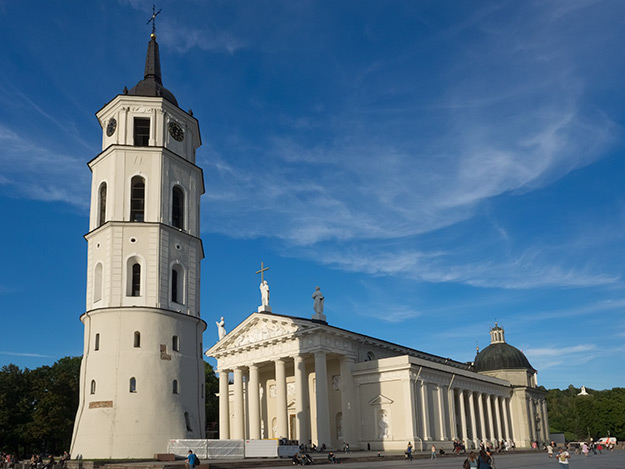
The belfry pointed me west down Gediminas Avenue. Most of the governmental institutions of Lithuania are found here. However, the real draw is cultural institutions like the Lithuanian National Drama Theatre and the Lithuanian Academy of Music and Theatre, as well as the upscale retail shops and restaurants in the area. This neighborhood has become so popular with residents and locals alike that Gediminas Avenue becomes a pedestrian-only boulevard every evening.
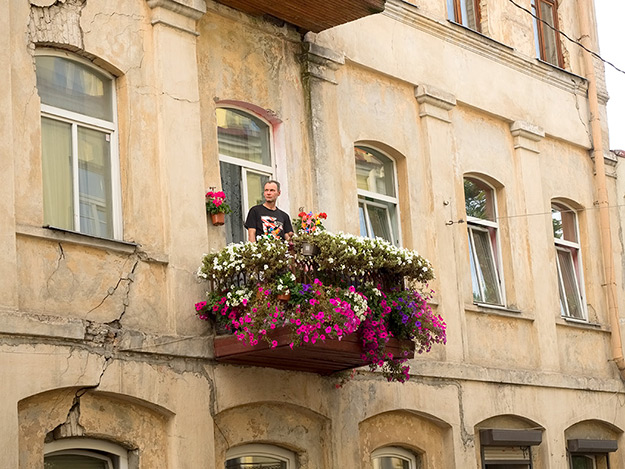
The district directly west of Old Town vibrated with youthful energy. Centered around the Presidential Palace and the University of Vilnius, it was rife with theaters, avant-garde cafes, coffee shops, and broad avenues lined with crumbling, yet still stately Neoclassical mansions.
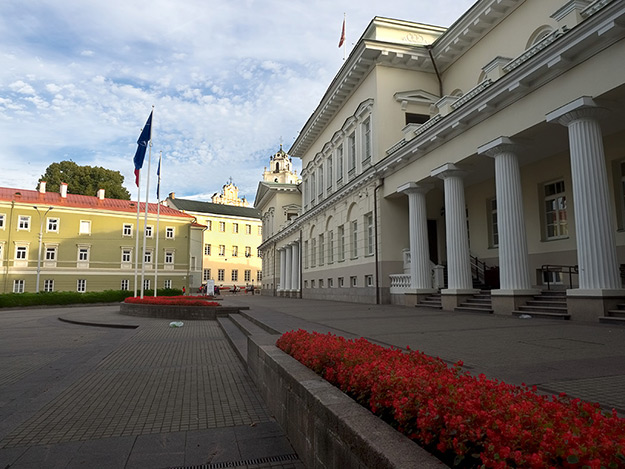
With only one day left and so much more to see, I turned to Valentyn for assistance. “The small and large Jewish Ghettos are worth a look. Someone found photos of the Jewish families that lived there before and during World War Two. Enlargements of the photos have been installed in the windows of the old row buildings. No one knows their names or their stories.” I took his advice and spent the afternoon peeking into inner courtyards where most of life is lived today, and contemplating the poignant reminders of the lives that were lost with every black and white portrait I passed.
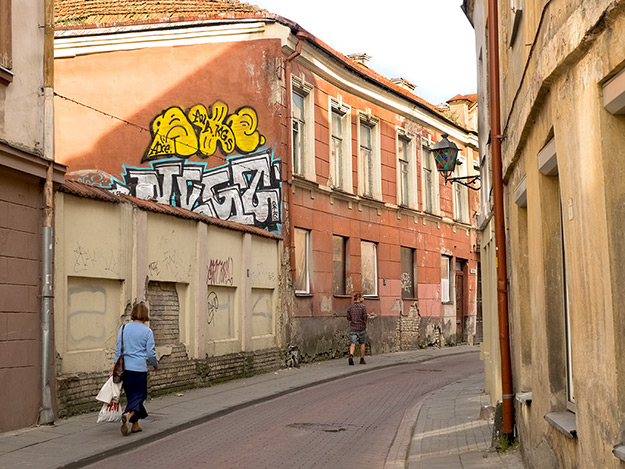
So often, the places I visit run together in my mind. I can conjure up mental images of them but am absolutely incapable of remembering where a particular site was located. The sights and sounds of Vilnius, however, are indelibly impressed on my mind. It is real. It is authentic. And it is one of very few places that I could return to, again and again.
Author’s note: For a complete list of what to do in Vilnius, stop by the Tourism Office in the Town Hall, located in the center of the historic Old Town. Also, the best way to travel around the Baltics is by bus. Readers will be pleased to know that after my uncomfortable experience with Ecolines, I traveled with Lux Express twice. I found them to be modern, comfortable, and clean buses, and their fares are on a par with Ecolines.

sadsa
Thank you for writing your article. I was there a decade or so ago and enjoyed our short visit. The zeppelins were much tastier than they looked. 🙂 The thing I regret the most was not buying some art while I was there. I wish I’d made time to see some of the student art places.
Hi Jen: Thanks so much for taking the time to leave a comment. I liked all the Baltic States, but I really LOVED Vilnius. It’s one of the few places on my short list of places to revisit. Glad to hear you had the same experience, and I suspect you’d find the art scene even more vibrant than it was 10 years ago.
No offense intended, Barbara, but the geographical knowledge of Americans is spotty at best, but often entirely non-existent. I have often wondered what Americans learn in school. So it doesn’t come as a surprise that neither Vilnius nor Lithuania are names an average American would know about. All Baltic countries have a strong history with Germany and German language. Reason for that is the medieval trade organization HANSE, which was established from German cities Lübeck, Hamburg and Bremen. But even before that, the Wikings have traded with the Baltic countries, at the time unilaterally called Nowgorod, an area stretching from the Baltic Sea to the Ural Mountains.
None taken Peter. I completely agree with your assessment of the educational system in the U.S. I’m constantly embarrassed by our geographic ignorance.
Vilnius is more than cool cos it’s pretty alluring. Thanks for the glimpse Barbara. Glad to came by. Your photos are beautiful too.
Thanks so much Faye.
You’re welcome. Hoping for more of your adventure. Keep going!
As our recent election has shown, it\’s not just the geographic education of Americans that is sorely lacking, it\’s the overall educational system. The goals seem to be twofold: teaching people how to be good low-level employees and keeping them from taking too hard a look at those at the top of the economic pyramid. Oh, and one more: keeping the cost to the \”tax payers\” as low as possible.
Libbie
yes you are write . No education in USA . The reason they are harming an educated foreighn born people .
Vilnius is truly a lovely city. And for me as a fan of beer even the better.
Although I must add – Lithuania is not the smallest of the Baltic states, but actually the largest by size and population (the smallest in both is Estonia, with Latvia in the middle).
Yikes, Ivars. That was a glaring mistake on my part. So sorry. I’ve just corrected it. Thanks for letting me know.